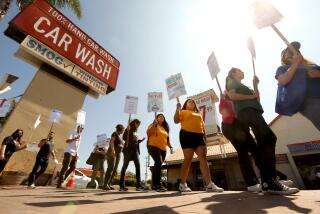Recently Laid-Off Miss Out on Boost
- Share via
An increase in state jobless benefits that was hailed as a safety net for Californians thrown out of work after Sept. 11 won’t apply to hundreds of thousands of workers already drawing benefits or laid off in the wake of the attacks.
The increase, the first in a decade, has been touted by Gov. Gray Davis and other politicians as a way to help workers hurt economically by the tragedy. But it applies only to new claims filed after Jan. 6.
Legislation authorizing the timing of the increase was drafted long before the terrorist acts. But that doesn’t make it any more palatable to workers such as Jacques Bechard, a former travel company manager, who will see newcomers to the unemployment line reap as much as $400 more a month starting in January.
“That’s a car payment for me,” said Bechard, who added that his $230-a-week benefit is barely enough to pay the rent on his Hollywood apartment. “When you’re out of work, every little bit helps.”
With the travel and tourism industry still reeling, the 52-year-old is sharpening his computer skills and looking for office work. Already halfway through his 26 weeks of unemployment benefits, Bechard has sent out a number of resumes, but with no results.
“They made a big show out of helping us,” he said of the publicity surrounding the benefits increase. “But people like me aren’t getting a thing.”
Years in the making, the increase was approved by the Legislature just days after the Sept. 11 terrorist attacks.
Davis signed the measure Oct. 1 at a ceremony at Los Angeles International Airport in a show of solidarity with the 1.1 million Californians working in the hard-hit travel and tourism industry, the state’s third-largest employment sector.
“This bill will provide a safety net for those suffering the ill effects from the softening of our economy,” Davis said at the time. “But our immediate concern is those affected by the terrorist acts on Sept. 11.”
The irony is that the very workers hit immediately by the post-attack fallout are among the least likely to benefit from SB 40, unless they have enough savings to tide them over until after the first of the year. Employment Development Department officials say they have been advising workers to delay filing until Jan. 6 to qualify for the increased benefits.
“There is no question that a portion of the people are waiting,” department Director Michael Bernick said.
But labor advocates say many couldn’t afford to wait, particularly low-income immigrants who work in the region’s hotels, restaurants and airports.
From mid-September through mid-December, more than 830,000 claims for unemployment benefits were filed in California, a 25% increase over last year, according to the EDD.
Facing the wrath of thousands of recently unemployed constituents, lawmakers are scrambling to close the gap. State Sen. Richard Alarcon (D-Sylmar) is set to introduce legislation in January that would make the benefits increase retroactive to July 1.
Even if successful, Alarcon acknowledged that left-out workers may not see anything extra in their benefits envelopes until May at the earliest.
By then, worker advocates say, many unemployed Californians will have exhausted their maximum 26 weeks of benefits or been pushed to the financial brink.
Kurt Petersen, organizing director for the Hotel Workers and Restaurant Workers Local 11 in Los Angeles, said even a small increase would be significant to his members, mostly immigrant hospitality laborers whose industry has been crushed by the collapse in travel and tourism.
“A few bucks a week could make the difference between them keeping an apartment or being homeless. By May it will be too late,” Petersen said. “It’s a disgrace that the airlines can get a multibillion[-dollar] bailout within weeks while workers have to wait months for pennies.”
Maximum Payout Will Nearly Double
As it is, California workers have been waiting a decade for a rise in their unemployment benefits, which were last raised in 1992 and are among the lowest in the nation.
Despite the state’s high cost of living, California’s maximum payout of $230 a week ranks 47th out of the 50 states. Only Mississippi, Alabama and Arizona pay their laid-off workers less, according to figures from the Washington-based Economic Policy Institute.
That will change in January, when legislation passed this year takes effect. Known as SB 40, the law will see California’s maximum payout nearly double over the next four years.
The biggest boost comes next month, when the top weekly benefit will jump to $330 from $230 weekly, providing some workers as much as $2,600 in total extra benefits compared with the old formula. Additional increases of $40 a week will follow each year until 2005, when the maximum payout will reach $450 a week.
Workers earning as little as minimum wage will see their unemployment benefits increase as well, albeit by a much smaller amount than top earners, according to the state employment department, which administers the unemployment insurance program.
The new law also makes it easier for part-time workers and students to qualify for benefits, groups that traditionally have been shut out because they earn too little or didn’t meet some other criteria under the old regulations. Currently, only about half of California’s 1 million jobless workers are receiving unemployment checks; some claims are pending while others are not eligible for assistance.
Alarcon, the author of SB 40, said he didn’t intend to penalize any laid-off workers. The legislation was in the works well before the terrorist attacks, he said, and state unemployment benefits increases historically have been paid only on new claims at the start of the calendar year following approval.
“No one could have predicted Sept. 11” and the resulting jump in joblessness, Alarcon said.
But that’s small consolation to workers who were among the first to get the ax.
“It’s unfair,” said Reina Castro, who is still wrestling with the paperwork for the claim she filed after losing her job cleaning airplane cabins at LAX shortly after the Sept. 11 attacks. “We are being punished twice.”
Union leaders say they’re getting an earful from their members. Professionals are registering their displeasure as well. Sus Kawamoto, a laid-off aerospace engineer, was so incensed at the disparity that he fired off complaints to the governor’s office, his state senator and his assemblyman.
“I think I’m entitled to the same benefits,” said the Harbor City resident, whose $230-a-week check would be $100 higher under the new formula. “People are going to be angry when they find out the guy next door is getting more” just because he lost his job a few weeks later.
Lawmakers Move to Work Out Fix
Hearing the rumbling from their constituents, legislators already are working on a fix.
Alarcon said his proposal to make increased benefits retroactive to July 1 will cost at least half a billion dollars, money that will come out of the existing $5.7-billion surplus in the unemployment insurance fund.
Other proposals being shopped around Sacramento include making the benefits boost retroactive to Sept. 11 or giving all laid-off workers, not just new filers, the increase starting in January. Davis has said he supports some kind of retroactive payments.
But none of it is likely to sit well with California businesses, which foot the bill for the state’s unemployment system. Workers contribute a portion of their pay for state disability benefits, but employers pick up 100% of the tab for unemployment insurance--as much as 5.4% on the first $7,000 of each employee’s wages.
The cost of the scheduled increase is projected to total at least $4.2 billion over the next four years.
Powerful groups including the California Chamber of Commerce and the California Manufacturing and Technology Assn. opposed SB 40, alarmed that the hefty benefits increase combined with rising unemployment will wipe out the surplus in the unemployment insurance fund as soon as 2004.
“If you go back and retroactively increase benefits, that means an even larger drain on the fund,” said Allan Zaremberg, president of the California Chamber of Commerce. “Does that mean the fund goes bankrupt sooner and requires a tax increase while we’re still recovering from a downturn? We shouldn’t be talking about retroactive benefits until we know the full impact, and no one has shown me any figures.”
More to Read
Sign up for Essential California
The most important California stories and recommendations in your inbox every morning.
You may occasionally receive promotional content from the Los Angeles Times.













